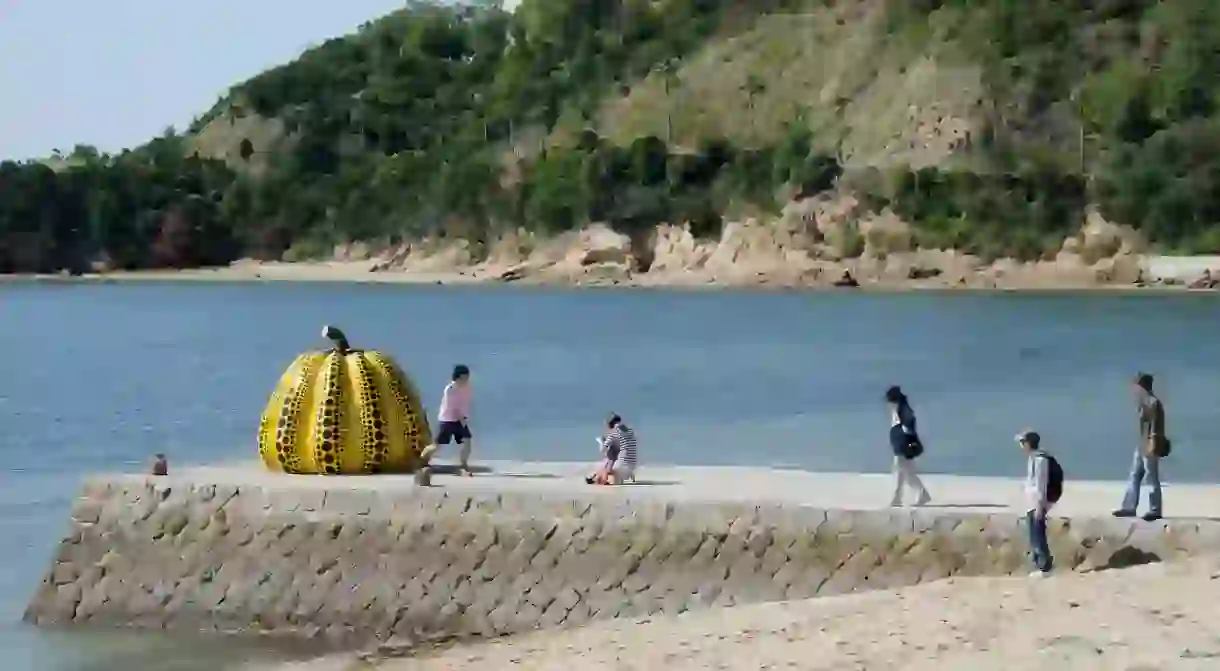An Art Lover's Guide to Naoshima

Situated in the Seto Inland Sea, the Japanese island of Naoshima is one of the most unique and unassuming art meccas of the world. Dotted with stunning beaches and even more stunning architecture and sculptures, this laidback island is one of the country’s most unique hideaways and a must-visit adventure for art fans of every calibre.
Brief history
The island’s artistic history starts with the Benesse Art Site. Benesse began as a dream by two men passionate about the cultural future of Japan and Naoshima’s potential to be an arts Mecca. In 1985, Tetsuhiko Fukutake, the founding president of educational publishing house Fukutake Publishing, met Chikatsugu Miyake the mayor of Naoshima to discuss the opportunity of developing a cultural and educational area on Naoshima. By 1992 the Benesse House Museum was opened and since then the company has continued to support and oversee the museums, installations and sculptures on Naoshima and its neighbouring islands.
The iconic: Benesse House
In many respects Benesse House is considered to be the heart of Naoshima. Sitting on the southern coast of Naoshima Island, the museum and resort style hotel is the central point of Benesse’s art facilities. The complex includes a museum, oval, park and beach; all of which were artfully designed by the world renowned self-taught architect Tadao Ando, who was inspired by the area’s natural surroundings. The art museum sits atop a hill overlooking the Naoshima coast, and although the view is incredible, it’s what’s inside the museum walls that really reflect the island’s natural beauty.
Featuring a broad selection of work by both Japanese and international artists, the Benesse museum is home to a permanent collection of works that are exclusive to the space. The curators have also commissioned a number of site-specific installations inspired by the area. Here, the line between architecture, art and nature are blurred – crafting a fully immersive art experience unique to Naoshima. Perhaps the most famous piece is Yayoi Kusama’s 1994 installation, Pumpkin, a glowing larger-than-life installation that sits on the edge of the pier overlooking the surrounding ocean.
761-3110 Kagawa Prefecture, Kagawa District, 直島町琴弾地, +81 8 7892 3223
The unique: Chichu Art Museum
Also designed by Ando Tadao, this unique modern art museum is built into a hillside of Naoshima’s south coast. What’s most striking about Chichu is that it is tucked underground and uses only natural sunlight to illuminate the museum’s works.
A visit to Chichu is a true lesson in architectural innovation and creativity. Though all of the works displayed here are impressive, the most attention-commanding portion of the collection is the works by American artist James Turrell. Turrell uses light as his main medium and the work Open Sky from his “Skyspaces” series is housed here. In order to maintain the carefully curated atmosphere, only a limited number of visitors are admitted to the museum at any one time.
761-3110 Kagawa Prefecture, Kagawa District, Naoshima 3449−1, +81 8 7892 3755
Immersive art experience: Art House Project
Trek towards the east of Naoshima and you’ll stumble across Honmura, a small port town that’s home to the Art House Project. The project is a collection of abandoned houses, work spaces, plus a temple and a shrine that have been reborn as art installations by local and international artists and architects.
Though from the outside many of the spaces are rather unassuming, the interiors have been fully converted into stunning art spaces. If you don’t have time to check out each of the buildings you can’t miss Kadoya – a house remade by Miyajima Tatsuo. Inside the 200-year old building is an LED display that’s submerged in a pool of water, a window transformed into a digital display, and an eccentric interpretation of traditional Japanese scroll painting.
Kadoya, 761-3110 Kagawa Prefecture, Kagawa District, 直島町(その他)792
https://www.instagram.com/p/BO5x20aBcoI/
The bathhouse turned art space: I Love Yu
If Naoshima is ideal for blurring the lines between art and everyday life, there’s no greater example than I Love Yu – an art installation and public bath house (sento).
Designed by Japanese artist Otake Shinro, here, guests can actually bathe in art. Shinro’s mish-mash scrapbook style incorporates recycled objects unearthed from different areas of Japan. With paintings, posters, video displays, collages and ceramics adorning every inch of the building, from the toilets to the exterior, it’s a one-of-a-kind art experience.
The man behind the island: Ando Museum
If there’s one figure responsible for what Naoshima is today, it is architect Tadao Ando who has designed the majority of Naoshima’s buildings and art spaces. Like many corners of Naoshima, the Ando Museum looks like a traditional residence from the outside, but once you step inside you’re stepping into another world entirely.
Combining the delicate design of Japanese interiors with Ando’s signature use of stark concrete, the contrasting atmosphere is unlike anywhere else in the world. Here you can learn all about Ando’s work and Naoshima’s architectural history through the museum’s vast collection of photographs, sketches, and models.
761-3110 Kagawa Prefecture, Kagawa District, 直島町736-2, +81 8 7892 3754













